Eastern Tn logging on the DG CC & W RR 1928
- Thread starter Bill Nelson
- Start date
You are using an out of date browser. It may not display this or other websites correctly.
You should upgrade or use an alternative browser.
You should upgrade or use an alternative browser.
Why thank you. I don't have a camera train although that would be fun. I tore out most of my best mountain scenery. got torn out in my rebuils. Most of what will go in will be less spectacular. It will however be much more operable, have a longer run, both on the standard gauge and the narrow guage. so far most of the scenery I have been working on has been the urban scenery of Harlow, the mythical 3rd largest city in Eastern Tn, smaller than Knoxville or Chattanooga, but larger than everything else in that neck of the woods. Dr. Tom came over this weekend, to review my plans for the upper deck; which will be my next project. that will have some mountain scenery reminicent of my old set up, but the bottom point will be four and a half feet high. on my old railroad I had ridelines that reached over six feet tall, and decended down to water level below three feet tall. I won't have any spectacular vistas like than on my new plan. Running trains will be a lot easier and more fun on my new set up. planning is all about compromises.
- Apr 5, 2013
- 14,215
- 10,837
My wife purchased a "G.E." camera, a Chinese Canon Elph knock off, at Sears, for $49 dollars. It's 10 megapixel, and shoots 1080P movies for about 20 minutes straight. Totally auto focus, and does timed shots. You could make some awesome videos. 
My digital camera does good video, but the best of my big scenery is gone. while my new rum will be much longer, much of it will be on narrow shelfs, and the Long sections of track on the central peninsula would show mainly the aisle. when I do the top level of the center peninsula, there will be some good scenic oportunities, but it will take years to build that scenery to the level of the old stuff I removed. My wife thinks I'm nuts for tearing out my old railroad. Those who operated it frequently were all like "Finally!"
Bill Nelson
Bill Nelson
my recent project has been making a tethered walkaround throttle . the tether, a long flexible cable is heavy and bulky, bet the power pack I cannibalized for the project had better slow speed control than any of my more sophisticated throttles. I though the process might interest someone who might not find it in this rather lengthy thread so I gave it it's own thread, found here.
http://zealotmodels.com/threads/bui...rottle-out-of-a-stationary-power-pack.177793/
as I said the throttle is bulky, and the tether will require me to clean out my aisles, but the slow speeds possible are a lot of fun, here is a link to a video there is some jerkiness to the video, this is an artifact of the camera, the trains run as smooth as glass
Bill Nelson
http://zealotmodels.com/threads/bui...rottle-out-of-a-stationary-power-pack.177793/
as I said the throttle is bulky, and the tether will require me to clean out my aisles, but the slow speeds possible are a lot of fun, here is a link to a video there is some jerkiness to the video, this is an artifact of the camera, the trains run as smooth as glass
Bill Nelson

I got another munitions crate at the local hardware store. My two GML Memory walkaround throttles have bases that are designed to be fachia mounted. On my old RR I had them in the center of the RR, near all my other control electronics, and the control panel. With my new set up utilizing a helix, my control panel is in my roll top desk and my electronics are in a wooden crate made to hold mortar rounds. This case, while similarly sized, seems to have held two artillery rounds. the primary electronics case has all the guts for throttles one two and four. I wanted the gml throttles mounted higher, as the base stations have a receptacle to plug in the throttles, which use a stereo headphone jack to plug in. the second photo shows the shortened crate, with cut out lines marked out for the GML throttles. I used a hole saw and a fat drill to drill some holes in the back of the crate, near the bottom. this will allow me to pass the power cord out to the power strip on the side of the primary electronics cabinet that allows all the layout power to be turned on or off at once, also wires would need to go out from each throttle to the layout common rail buss, the throttle control input on the control panel, and the three wire control circuit that would lead to stereo headphone jacks strategically placed around the room. as soon as I have the holes cut for the GML base stations, I will screw this smaller box on top of the main case, and then I can start wiring in the GML units, winch will be throttle # 3 and throttle #5. right now I only have four blocks wired in so five throttles will be excessive. I really like my GMl throttles, which can get some decent slow speed control, have variable momentum effects, with some four position braking available.
Nelson
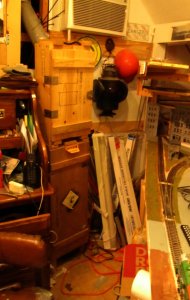
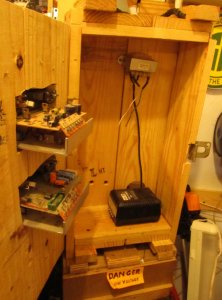
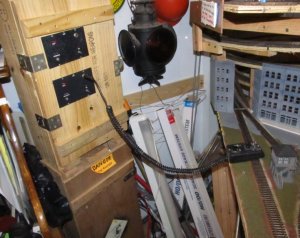
I have my shortened ex munitions box electrical cabinet annex , and mounted it on top of the primary electrical box with a couple long screws . the result is a little tippy. the pipe behind the electrical cabinet is a vent for a gas fireplace, I have some repairs to make to it in the attic ; and then I will strap the top of the electrical cabinet annex to it to stabilize it. The primary electrical box was designed, according to it's markings, to hold illuminating flare rounds for a mortar. The annex, according to it's markings, was made to hold two High explosive artillery rounds. Now it will hold the base stations for my two DC GML memory walkaround throttles with momentum, and braking. These throttles use standard size 3 wire stereo headphone jacks. each of these two throttles will have a three wire control loop that will run around the fachia of the layout. I will color code the plugs by putting red heat shrink around one of the plugs, and painting a red circle around that throttle's headphone jacks. with these throttles you can control the locomotive on any selected block while the throttle is plugged in. you can unplug the throttle, and when you do so the locomotive continues in it's current direction, at it's current speed, until the throttle is plugged in at the next headphone jack. each throttle has a wheel mounted on the top where you can set the degree of momentum effects you want. there is a switch on the throttle with a position that says RUN, BRAKE 1, BRAKE2, BRAKE3, BRAKE4 , AND BRAKE5, The last being an emergency brake, that stops the locomotive in it's tracks. I usually run without the momentum effects, but it can be fun to use the momentum effects on full, and try to stop the train just where you want it with the brake effects.
The guy who runs GML is pretty impressive. when I bought my first one, he asked me to critique it for him, my Innovator 2000 had a feature where there was a switch, which when thrown gave you half power when the throttle was at full. this helped with slow speed, especially with locomotives that ran well above their realistic speed at 12 volts. He built that feature into a throttle and sent it to me at no charge. when I bought the second throttle, that was a standard feature. since then I have done a lot of re motoring and re gearing, and I don't use that feature as much as I used to, but it is handy with some locomotives.
Inside the boxes I have mounted the power sources that will provide the 12-18V ac input that the GML units require. lots of other wiring to due. I will add terminal strips, and do it all neat and organized. I'm really wanting to work on this, but it should not be my priority. I have a river crossing on the bottom side of Murray TN. where I need to be working on scenery. I like to do the scenery before I install a bridge. that way I don't get glue paint and plaster on the bridge, and the bridge isn't in the way when I do the scenery. that way the scenery can be top notch, and so can the bridge. Bridges are natural focal points, folks will be spending a lot of time looking at them, so you want that area to look as good as possible; folks will assume the places they don't study so hard will be just as good. So I need to do some scenery before I can put in the bridge, and I have to put in the bridge before I can extend my track farther on the lower level. I have track installed on the helix, and on the industrial siding on the back side of Harlow. Neither of these areas will be accessible until I wire the hand laid crossings across the Southern main line. once I have those wired, I can start pushing track onto the upper level. I have three working throttles now, and only four working blocks. I don't need these throttles right now ( but they are fun to use). I need to be working on getting the Southern crossings wired, and doing the scenery on the Crooked Creek western bridge ( there are two crossings of Crooked Creek farther east in Tom's Bend near the sawmill town of Crooked Creek.
Bill Nelson
I got a Tsunami installed in an ancient Riverossi heisler (documented in it's own thread, here is a link to a video on you tube.

working to try to clean off my workbench, I uncovered my old #4, a Westside models horizontal boilered Class a climax. It is a stout little beast. the original motor had a plastic bearing/ brush holder. I used it as a road engine, and it's incredible gearing, 88-1 , caused the motor to run hot, melting the block, which would then get the brushes out of alignment. Westside was good about providing me motors at no cost, but i eventually put a can motor in it, and had no more motor issues. I did have to replace the drive shafts. It came with nice little universals and slip joints, but they eventually broke. I put NWSL cardigan shafts in, but the design was not stout enough, it would bust the little plastic balls of the cardigan shafts before the locomotive would get to full slip. I used the NWSL cardigan cups, and made brass cardigan shafts to fit them. thatr worked for years, but one of the cardigan cups had split. fortunately I had some spares . I fixed it this am between turkey bastings. some day I need to take it apart and completely re wire it, adding all wheel pick up, as it's light weight, and tiny wheel base cause electrical pick up issues on occasion. It will be tricky, cause it is so tiny there won;t be much room for extra wires.
Likely I will put this little critter in service for the Strong and perry lumber co. on the top deck when that gets built.
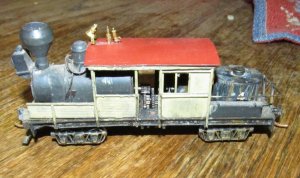

working to try to clean off my workbench, I uncovered my old #4, a Westside models horizontal boilered Class a climax. It is a stout little beast. the original motor had a plastic bearing/ brush holder. I used it as a road engine, and it's incredible gearing, 88-1 , caused the motor to run hot, melting the block, which would then get the brushes out of alignment. Westside was good about providing me motors at no cost, but i eventually put a can motor in it, and had no more motor issues. I did have to replace the drive shafts. It came with nice little universals and slip joints, but they eventually broke. I put NWSL cardigan shafts in, but the design was not stout enough, it would bust the little plastic balls of the cardigan shafts before the locomotive would get to full slip. I used the NWSL cardigan cups, and made brass cardigan shafts to fit them. thatr worked for years, but one of the cardigan cups had split. fortunately I had some spares . I fixed it this am between turkey bastings. some day I need to take it apart and completely re wire it, adding all wheel pick up, as it's light weight, and tiny wheel base cause electrical pick up issues on occasion. It will be tricky, cause it is so tiny there won;t be much room for extra wires.
Likely I will put this little critter in service for the Strong and perry lumber co. on the top deck when that gets built.

Did some work on the dispatcher's desk, fixing up the control panel by replacing my hand lettered labels with stick on letters from Hobbl lobby's scrapbooking aisle
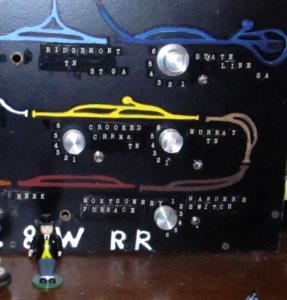

The cork board on the keyboard shelf od this old computer desk will be painted up with a track diagram showing the various blocks for the dispatcher to use push pins to keep track of train movements.
Nelson


The cork board on the keyboard shelf od this old computer desk will be painted up with a track diagram showing the various blocks for the dispatcher to use push pins to keep track of train movements.
Nelson

I have gotten the cardboard strips forming the land mass on either side of the Western crossing of Crooked Creek staped and hot glued in place. I have wax paper between the land forms and the shetrock walls, so when I glue the handiwipes to the cardboard, and put plaster on top, I won't mess up the shetrock walls behind the railroad.
I like to get the senery under a bridge close to compleate before I install the bridge. that way the bridge doesn't get in the way of making great sceneary, nor does plaster, paint, glue and other scenery material get all over the bridge. as soon as the bridge is in place, I;ll be able to add about eighteen feet of main line, a long passing siding, and a lonf stub siting, which I cah use as staging until more of the lowest level is compleated.
Nelson
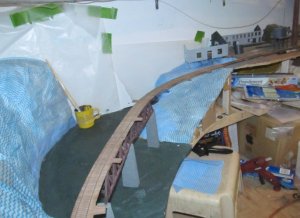
My current Glue shell tequnique, which I have developed pretty much on my own, is a variation of the old Hardshell method, which used paper towels dipped in soupy plaster. I did that for years, and always made a horrible mess.
Instread after making up the land forms as seen in earlier pictures with strips of carboard stapled or hot glued to the wood benchwork, and the enterwoven, basketweaving style with itself, glued to gether at as many spots as possible with hot glue. I then cover it with handiwipes. I paint the carboard near the edges of a sheet of handiwipes with white glue just slightly dilluted with water and liquid dishwashing detergent. in the middle of a section of landform under the entended location of the handiwipe I paint the cardboard with a souloution that is perhaps two thirds white glue, and one third water. Once the handiwipes are in place on the land form I paint the entire surface of the handiwipe with a souloution of 50 50 white glue and water with a drop or so of diswasher detergent.
Where there will be rock outcroppings the handiwipes will be covered with a genrerous layer of hydrocal plaster, which I then carve the rocks into. where it is just gravel and dird, I will paint the handiwipes with acrrilic paint, to insure no light blue shows later, and then with full strengthe white glue, followed by whatever ground cover I;m using, followed by diluted white glue, watter, and detergent, as one would do gluing ballast down, the handiwipes, the groundcover, and the glue will make the scenery strong enough.
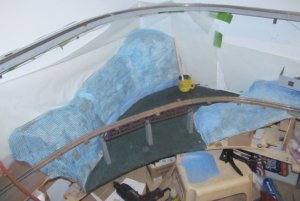
The builkding to the right is a tannery, they would get bark, surpluss from the logging site, soak it in water in big vats to get tannic acid, and use the tannic acid to tan leather, this Tannery used to be on the backside of my old Harlow, but was not finished when that section of my own layout was torn down. in gets a new life here near the banks of Crooked Creek

I built this bridge out of pieces of four different bridges from my own layout. the decks came from two bridges that were built very close to eachother time wise, and thus had bridgeties cut to the same size, and out of the same materials. I removed the old code 70 rails, and installed code 83 rails, and spliced them together. the two steel spand are Atlas products, and they and one of the peirs came from a third bridge, and the other two piers came from a fouth bridge. Likely this will be the longest bridge on my RR.
Nelson

I picked up two MDC arch roof cars, an observation, and a baggage, to add to the Southern Model Power car I had. I had two more The model Power cars on oder when they went belly up. the model power cars. the MDC cars were not available in Southern Green, so I played with spray paint cans. Hunter green was too dark, but I gave them a base of hunter green, and then gave them a light coat of John Deere green, and really like the results, may repaint the Model power car, which is not as close to the green on the Bachman 2-8-0, which looks just right to my eye.
I also picked up four MDC Pullman Palace cars lettered for the Southern Crescent. They will live at the club, they would overpower this station. When I get the southern Staging set up I now have two Southern Passenger trains that can come and go in each direction. am considering picking up a Bachman green and gold 4-4-0 with a Tsunami for my Southern open platform coaches.
Had not done much modeling recently , had made a trio to Ohio for my #1 son's graduation form graduate school (Chemical engineering, University of Dayton), then went to Houston a few days later to visit family for Christmas. Made another trip to Houston Last weekend to see my New Grandson, our first. Laying low, trying to recover this weekend, although I did replace a toilet, with one that will actually flush.
Have spent some more time working on an HOn3 2-8-0 I'm considering putting a Tsunami in. have spent some time up in the RR room, but not much.
I just got done going through all my old posts, and editing them back to full photos, from where they had been changed to thumbnails during the platform change. the whole archive is now view friendly again should anyone want to take that "Long strange trip."
Have been real busy, have been cleaning up my work bench, and my wife found a cabin on Kentucky lake that was just what she was looking for, and a deal, so we are doing some real estate stuff for a 2nd home. The place is about an hour and fifteen minutes from the farm; there is a full basement, but I will need to clean up my work area in my family room, and my computer desk and keep them clean for a long time to secure any right of way there.
have been off for a week and a half due to snow, and am on spring break, live the school job, Life is good, will have to post some stuff soon, hope to get to work in the RR room this week. there is no heat up there but what drifts up from the rest of the house, and it has been very cold by local norms. it is warming up; have a lot of errands to do today, but hope to work on the trains soon, doing scenery around the lower crossing of Crooked creek, so I can extend track onto the long lower shelf on the east wall; and I hope to get the wiring done on the crossings in Harlow, which would allow trains to get onto the helix up to the upper level, which might inspire me to getting some benchwork up there to get closer to having log and ore trains rolling!
Have been real busy, have been cleaning up my work bench, and my wife found a cabin on Kentucky lake that was just what she was looking for, and a deal, so we are doing some real estate stuff for a 2nd home. The place is about an hour and fifteen minutes from the farm; there is a full basement, but I will need to clean up my work area in my family room, and my computer desk and keep them clean for a long time to secure any right of way there.
have been off for a week and a half due to snow, and am on spring break, live the school job, Life is good, will have to post some stuff soon, hope to get to work in the RR room this week. there is no heat up there but what drifts up from the rest of the house, and it has been very cold by local norms. it is warming up; have a lot of errands to do today, but hope to work on the trains soon, doing scenery around the lower crossing of Crooked creek, so I can extend track onto the long lower shelf on the east wall; and I hope to get the wiring done on the crossings in Harlow, which would allow trains to get onto the helix up to the upper level, which might inspire me to getting some benchwork up there to get closer to having log and ore trains rolling!
Last edited:
Not gotten much done In spite of being snowed out @ school for close to two weeks, and then having spring break. The wife found a deal on a cabin on Kentucky Lake, and working to get that deal done has ate a lot of time. I have been planning on putting in a icing platform in Harlow yard. I realized I did not have many refrigerator cars. I picked up a couple very nice Atlas billboard wooden sided refrigerator cars; and that made me get interested in working on the icing platform. I have a Tichy kit, which like all their stuff is very well done. Have built two of the three sections built. As is, it would make a two car long icing platform; or I can build the third, and have room to ice three cars. it will add operational interest, as that could add a stop for a car going through Harlow, either on the Southern, or the DG, CC, & W RR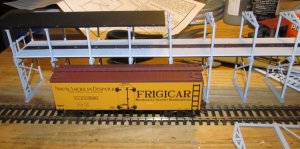

Have been having a lot of fun (not) trying to wire up the crossings where the Southern main crosses my main and one of my sidings. am wiring them off the DPDT switch on a blue point controller, so that the crossings will be wired for the Southern main, when the switch is thrown for the southern, and for the DG CC & W RR when it is not.
The first one worked like a charm, but as I hooked up the second I got a dead short. when I soldered it up I used rails set parallel to the ties to help hold the guard rails in place, and when I gut the gaps one of those rails did not get cut all the way through, giving me a dead short. It drove me nuts, but I finally figured it out. with a little more work with a grinding wheel in the dremil; I should be able to fix it, and then I will be able to get trains through both crossings, which will allow me to wire up the helix block, and the Southern staging. I also took time today to move a lot of the pieces of plywood out of my aisles and into the attic, so it is much easier to move around in the aisles. It is no longer too cold up there , and it isn't hoot enough to need the AC up there. will be really busy though; the wife found a deal on a cabin on Kentucky Lake, about an hour west of here, so there will will be a lot of time spent at the lake. it has about a 1,000 foot garage space under it; but I will have to do some huge cleaning of my garage and work area, if I have any hope of getting any right of way at the lake.
The first one worked like a charm, but as I hooked up the second I got a dead short. when I soldered it up I used rails set parallel to the ties to help hold the guard rails in place, and when I gut the gaps one of those rails did not get cut all the way through, giving me a dead short. It drove me nuts, but I finally figured it out. with a little more work with a grinding wheel in the dremil; I should be able to fix it, and then I will be able to get trains through both crossings, which will allow me to wire up the helix block, and the Southern staging. I also took time today to move a lot of the pieces of plywood out of my aisles and into the attic, so it is much easier to move around in the aisles. It is no longer too cold up there , and it isn't hoot enough to need the AC up there. will be really busy though; the wife found a deal on a cabin on Kentucky Lake, about an hour west of here, so there will will be a lot of time spent at the lake. it has about a 1,000 foot garage space under it; but I will have to do some huge cleaning of my garage and work area, if I have any hope of getting any right of way at the lake.
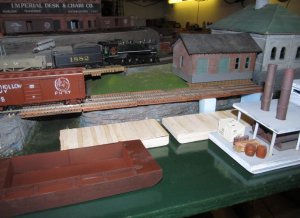

Made some progress today. I got a steel barge (foamcore and meat trays covered with cardboard.) painted, and I got the boards on two of the three small barges that will be a floating dock for the steamboat and barge traffic.
I have been fighting the wiring on the handlaid crossing where the DG, CC, & W RR main and the Southern Northbound main cross each other. When I cut the gaps through the diamond, I didn't get all the way through a rail between the ties, so what looked like a gap wasn't. then I had the two corners of the diamond that were not switched wired backwards. I finally got it figured out though. now I can wire up the helix, and Southern staging.
The two switched corners of the diamond are powered off of the switch where the Southern main departs form my main line. I have that switch powered by a Blue Point switch controller. the Blue point controller is hooked up to a cable, so it can be actuated from either side of the peninsula. the blue point controller has a DPDT switch built into it, and I have that wired as a reverser. when the switch is thrown to the Southern, the crossings are wired for the Southern. when the switch is thrown to the DGCC&WRR; the crossings are powered for the DG CC &W RR. It was an elegant solution; but I seriously botched the installation. Glad I figured out what I did wrong, as it was driving me nots!
Nelson
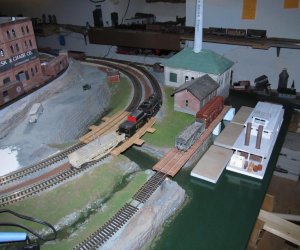


The decked barges that will make up the floating dock for the riverboat and barges have been spray painted. they are built up of foam core, and foam from meat trays and then planked with coffee stirrers that have been grained by dragging them under a razor saw. I need to cut more foam supports to go under the track, and then carve stone work into them. some pilings will be in order, and I will have to get some castings for the tie down thingies that should be at each corner of the dock barges and along the side of the riverboat. I'll paint some planks similarly to the deck of the dock/barges to plank over between them If that DPM brick freight house stays there, it will get a proper foundation to level it up properly.
Progress has been very slow, we made a trip to see the Grandson @ Easter; and have been in the process of buying a lake cabin, and moving some stuff there; so I have had little train time.


